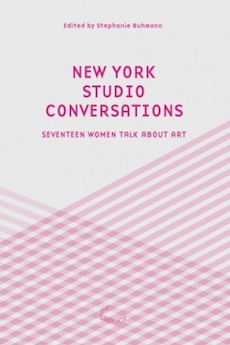By Svetlana Alpers
I admit I opened this book with some suspicion; first, why women artists only? and what is meant by talk about art? But I have come to have respect for this compact and elegantly or, better put, strictly designed volume. It is a gem. I now find it very interesting. Buhmann, a German-born American educated art writer, answers my questions in her brief preface. Only women began as a way to narrow the field, but it was given authority for her when she came across the German artist Georg Baselitz quoted as saying that in his opinion “women couldn’t paint as well as men.” A striking feature of the book, however, is that gender itself is never the topic of conversation. As for talking about art, her decision was to makes the studio a place to speak—not to speak about the studio as such, but to address art in the making before it goes out into the greater world (which Buhmann, curiously, refers to both as its “emancipation” and also as “outside manipulation”). It is a fine alternative to all the hype about money and the market that dominates so much writing on art these days.
The conversations are characteristically concerned with materials—the materials and processes with which the artist works. The accounts here are of doing hard physical work. By contrast, “Ideas are cheap” as Hermine Ford remarks. Most of these artists were trained in art schools to draw and paint, and I assumed (sculptors aside) that they worked on rectangular surfaces. It is interesting that hardly any of them have continued to do so. (Riley, Meyer, and Gourevitch are exceptions. Meyer is also the artist who speaks up for traditional technical training and, perhaps related to that, frequently mentions painters in the tradition who came before her time.) They work on oddly shaped surfaces of different kinds, and often in media which are not paint—burnt canvas, textiles, ceramic tiles, drawing on its own and even sound. A frequent reason given is that of kicking free (or some other similar term). Wayne says more interesting. As a longtime observer of historic paintings, I have thought that the constraint of working in oil on a rectangular canvas had been useful—giving the artist something to work within and also against. That was the nature of the European and earlier American pictorial tradition. It is interesting that leaving painting behind was related to “going public” for some of these artists (Kozloff). Surely any exhibition of art is a matter of going public. But public has a special, much broader meaning for artists these days. However, I think there is an inherent danger that the rush to the public installation of art overwhelms attention to its making—for artists and for viewers. The conversations in this book serve as an antidote to that condition.
I am a purposeful reader of books. I generally begin at the beginning and read thru to the end—not flipping around on the way. It was only when I was all finished reading that I managed to turn to the final pages and see the illustrations—one for each artist, and further on the titles, size and “courtesy of.” It is interesting to see which have dedicated galleries and which apparently not. Until then, the interest of the conversations is that they were, so I thought, unillustrated—there was a similarly posed photo of each artist (Apfelbaum excepted), but you had no idea what the works the artists were talking about looked like. I even went on line to track some down. My mistake. But there is an elegance about putting the images at the end. As you read, the words and practice of making being described stand on their own. That makes for surprises. Butterly is a ceramicist working with porcelain who is most articulate about her makings: tough but also fragile; being loud and silent at the same time; the works remain small but they become a universe to me. Still, when I found one illustrated at the end of the book I was not prepared for what I saw. I had to make an adjustment. Look for yourself and see!
But also read a book which brings to the fore the intelligence of artists who are working if not against at least despite the power of commerce.
Svetlana Alpers, an artist, critic and renowned art historian, is professor emerita of the history of art at the University of California, Berkeley and a visiting scholar in the Department of Art History in New York University.




